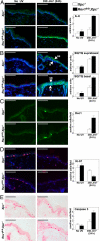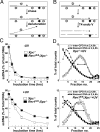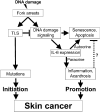Error-prone translesion replication of damaged DNA suppresses skin carcinogenesis by controlling inflammatory hyperplasia
- PMID: 20007784
- PMCID: PMC2799833
- DOI: 10.1073/pnas.0909507106
Error-prone translesion replication of damaged DNA suppresses skin carcinogenesis by controlling inflammatory hyperplasia
Abstract
The induction of skin cancer involves both mutagenic and proliferative responses of the epidermis to ultraviolet (UV) light. It is believed that tumor initiation requires the mutagenic replication of damaged DNA by translesion synthesis (TLS) pathways. The mechanistic basis for the induction of proliferation, providing tumor promotion, is poorly understood. Here, we have investigated the role of TLS in the initiation and promotion of skin carcinogenesis, using a sensitive nucleotide excision repair-deficient mouse model that carries a hypomorphic allele of the error-prone TLS gene Rev1. Despite a defect in UV-induced mutagenesis, skin carcinogenesis was accelerated in these mice. This paradoxical phenotype was caused by the induction of inflammatory hyperplasia of the mutant skin that provides strong tumor promotion. The induction of hyperplasia was associated with mild and transient replicational stress of the UV-damaged genome, triggering DNA damage signaling and senescence. The concomitant expression of Interleukin-6 (IL-6) is in agreement with an executive role for IL-6 and possibly other cytokines in the autocrine induction of senescence and the paracrine induction of inflammatory hyperplasia. In conclusion, error-prone TLS suppresses tumor-promoting activities of UV light, thereby controlling skin carcinogenesis.
Conflict of interest statement
The authors declare no conflict of interest.
Figures





Similar articles
-
Error-Prone Replication through UV Lesions by DNA Polymerase θ Protects against Skin Cancers.Cell. 2019 Mar 7;176(6):1295-1309.e15. doi: 10.1016/j.cell.2019.01.023. Epub 2019 Feb 14. Cell. 2019. PMID: 30773314 Free PMC article.
-
Requirement for functional DNA polymerase eta in genome-wide repair of UV-induced DNA damage during S phase.DNA Repair (Amst). 2010 Jul 1;9(7):754-64. doi: 10.1016/j.dnarep.2010.03.013. Epub 2010 Apr 24. DNA Repair (Amst). 2010. PMID: 20457011
-
Rev1 promotes replication through UV lesions in conjunction with DNA polymerases η, ι, and κ but not DNA polymerase ζ.Genes Dev. 2015 Dec 15;29(24):2588-602. doi: 10.1101/gad.272229.115. Genes Dev. 2015. PMID: 26680302 Free PMC article.
-
Filling gaps in translesion DNA synthesis in human cells.Mutat Res Genet Toxicol Environ Mutagen. 2018 Dec;836(Pt B):127-142. doi: 10.1016/j.mrgentox.2018.02.004. Epub 2018 Feb 23. Mutat Res Genet Toxicol Environ Mutagen. 2018. PMID: 30442338 Review.
-
UV-induced skin damage.Toxicology. 2003 Jul 15;189(1-2):21-39. doi: 10.1016/s0300-483x(03)00150-1. Toxicology. 2003. PMID: 12821280 Review.
Cited by
-
Starvation promotes REV1 SUMOylation and p53-dependent sensitization of melanoma and breast cancer cells.Cancer Res. 2015 Mar 15;75(6):1056-67. doi: 10.1158/0008-5472.CAN-14-2249. Epub 2015 Jan 22. Cancer Res. 2015. PMID: 25614517 Free PMC article.
-
Rev1 overexpression accelerates N-methyl-N-nitrosourea (MNU)-induced thymic lymphoma by increasing mutagenesis.Cancer Sci. 2024 Jun;115(6):1808-1819. doi: 10.1111/cas.16159. Epub 2024 Apr 4. Cancer Sci. 2024. PMID: 38572512 Free PMC article.
-
Inhibition of mutagenic translesion synthesis: A possible strategy for improving chemotherapy?PLoS Genet. 2017 Aug 17;13(8):e1006842. doi: 10.1371/journal.pgen.1006842. eCollection 2017 Aug. PLoS Genet. 2017. PMID: 28817566 Free PMC article. Review. No abstract available.
-
Overexpression of Rev1 promotes the development of carcinogen-induced intestinal adenomas via accumulation of point mutation and suppression of apoptosis proportionally to the Rev1 expression level.Carcinogenesis. 2017 May 1;38(5):570-578. doi: 10.1093/carcin/bgw208. Carcinogenesis. 2017. PMID: 28498946 Free PMC article.
-
REV1 coordinates a multi-faceted tolerance response to DNA alkylation damage and prevents chromosome shattering in Drosophila melanogaster.PLoS Genet. 2024 Jul 29;20(7):e1011181. doi: 10.1371/journal.pgen.1011181. eCollection 2024 Jul. PLoS Genet. 2024. PMID: 39074150 Free PMC article.
References
-
- Kundu JK, Surh YJ. Inflammation: Gearing the journey to cancer. Mutat Res. 2008;659:15–30. - PubMed
-
- Mueller MM. Inflammation in epithelial skin tumours: Old stories and new ideas. Eur J Cancer. 2006;42:735–744. - PubMed
-
- Melnikova VO, Ananthaswamy HN. Cellular and molecular events leading to the development of skin cancer. Mutat Res. 2005;571:91–106. - PubMed
-
- Lehmann AR, et al. Translesion synthesis: Y-family polymerases and the polymerase switch. DNA Repair. 2007;6:891–899. - PubMed
-
- Gan GN, Wittschieben JP, Wittschieben BØ, Wood RD. DNA polymerase zeta (pol zeta) in higher eukaryotes. Cell Res. 2008;18:174–183. - PubMed
Publication types
MeSH terms
Substances
LinkOut - more resources
Full Text Sources
Molecular Biology Databases

